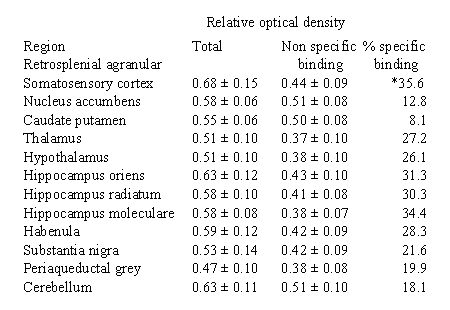| pA2
online © Copyright 2003 The British Pharmacological Society |
057P
University of Surrey Summer Meeting June 2003 |
|
Quantitative
autoradiography of [3H]paracetamol
binding in the mouse brain |
Print abstract Search PubMed for: |
The mechanism
of action of paracetamol as an analgesic has not yet been elucidated.
Several groups have studied its affinity for different receptors using
radioligand binding techniques. However no significant interaction between
paracetamol and G-protein coupled receptors has yet been found (Pelissier
et al., 1996; Raffa et al, 1996). Autoradiographic studies
with [3H]paracetamol at 30nM failed to
show any specific binding to murine brains (Courade et al., 2001).
However this concentration is more than 1000 fold below the therapeutic
plasma concentration and we have therefore carried out a new study using
a more appropriate concentration (3µM).
Adjacent coronal sections (20µm) were cut at 300µm intervals
from brains of 6-8 week old CD1 male mice and processed for autoradiography
as previously described (Kitchen et al, 1997). Binding was carried
out in 50mM Tris HCl (pH 7.4) using 3µM [3H]paracetamol
(32Ci/mmol), a concentration comparable to therapeutic concentrations
(Prescott, 1996), for a period of 1 hour at room temperature. Non-specific
binding was determined in the presence of 3mM unlabelled paracetamol.
Sections were apposed to tritium-sensitive film and analysed by video-based
computerized densitometry to determine total and non specific binding
in twenty-three brain regions.
Table 1 shows quantitative binding in selected regions. Two way ANOVA
(for the factors binding and region) showed no significant difference
between regions (P>0.05) but a significant difference between
total and non specific binding (P<0.001). Post-hoc analysis
(Fisher LSD test) of individual regions showed only one region where total
and non-specific binding was significantly different (P<0.05
).
Table 1: Binding of 3µM [3H]paracetamol
in murine brain (n=4, mean ± s.e.m, *P<0.05).

These data suggest that paracetamol binding is homogenous and, although
there is some indication of specific binding, the level of specific binding
in most regions failed to reach statistical significance.
Courade, J.P., et al(2001). Life Sci., 69, 1455-1464.
Kitchen, I., et al (1997). Brain Res., 778, 73-88.
Pelissier, T., et al (1996). J. Pharmacol. Exp. Ther.,
278, 8-14.
Prescott, L.F. (1996). Paracetamol (Acetaminophen). A Critical Bibliographic
Review. Taylor and Francis, London.
Raffa, R.B. et al (1996). Life Sci., 59, PL37-PL40.